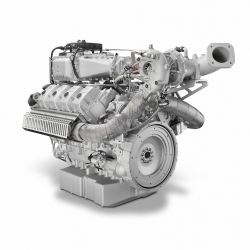The MAN E3268

The MAN E3268 LE222
The power output has been increased over its predecessor by 40 percent to 370 kWmech . Optimization of the engine specifically for natural gas or special gas, such as biogas, gives operators flexibility to use the fuel available for a particular project. The newly developed base engine is in line with the latest technological standards and provides maximum efficiency in operation as well as in maintenance and service.
The E3268 engine delivers up to 370 kWmech at 1,500 rpm. Depending on the gas used, its efficiency amounts to up to 42 %mech. As the pressure losses in the coolant circuit of the gas engine have been reduced, a smaller external engine coolant pump can be used. This in turn improves overall system efficiency. Efficiency under partial load has also be significantly increased. With its cylinder bore of 132 mm and a stroke of 157 mm, the E3268 LE2x2 now develops its power from the 17.2-liter displacement. Its output of 21.5 kW per liter is also considerably higher than the E2848 predecessor. The natural gas as well as the special gas variants comply with the current German TA-Luft emissions directive.
The engine is extremely flexible: It comes as the E3268 LE212 for natural gas operation with a compression ratio of ε 12:1 or as the E3268 LE222 for biogas operation with a compression ratio of ε 14:1. "Both power units are ideally configured for their intended purpose through the design of the combustion chamber and specially adapted pistons and turbocharger", said Hubert Gossner, Head of Power MAN Engines.
In addition to increasing the power output of the new eight-cylinder engine, the engineers are deliberately counting on the consistent reliability of MAN engines. "The base engine of the E3268 has already proven itself for many years in agricultural machinery, marine engines, and in the heavy-duty truck sector. On this basis, MAN has perfected a reliable engine developed in line with the latest technology and subjected it to comprehensive field trials", said Gossner. The new technology includes a 4-valve cylinder head optimized for the charge cycle, and reduction of friction inside the engine through use of, for instance, roller tappets or special sliding bearings. A new feature for customers is electronic data recording using sensors for parameters important for operation such as coolant temperature, boost pressure, and oil pressure. With a CAN interface these data can be easily made available for controlling the system.